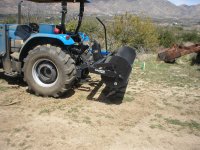Draft control, hydraulic TNT, and laser guided machine control are all wonderful tools, and I'm sure they'll all make grading and leveling easier, but for many of us, the financial outlays for this equipment is out of reach. I use older tractors because they fit my budget. It may take a bit more effort, but that's okay. I'm not in a race. Here's my take on box-blading:
1. Keep it slow! You'll need one hand on your steering wheel and one hand on your 3PH lift lever. Bumps and hills in your path will change the attitude of your tractor and implement. You'll want to be moving slow enough to compensate.
2. Weight is your friend. The more, the better. This goes for tractor and implement.
3. Adjust your top link to match conditions and the job at hand. I use a hinge-back blade, so what I do may very well be different from many others. In my case, a shorter top link lets it ride on the side plates and results in more of a scraping/smoothing operation, whereas lengthening it gives a more aggressive cut. (Fixed blades are opposite.)
4. Keep it slow. This ain't no land plane.
5. Make multiple shallow passes. Digging too deep and trying to do it in one pass will result in dips, hills and craters. Skim a little bit off at a time, spread it around and stop to see what it looks like. Repeat.
6. Did I mention speed? Good!
7. Patience! Like I said, I don't have the newest fancy equipment with the latest in gadgetry, but I can still get very good results with a box-blade... Provided I slow down, take my time, pay attention to what's going on at the point of engagement and adjust accordingly.
8. Practice. The more you do it, the better you'll get.
Joe

